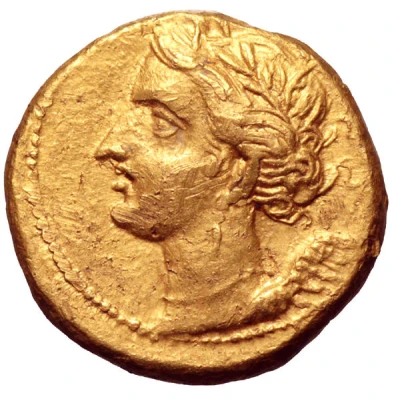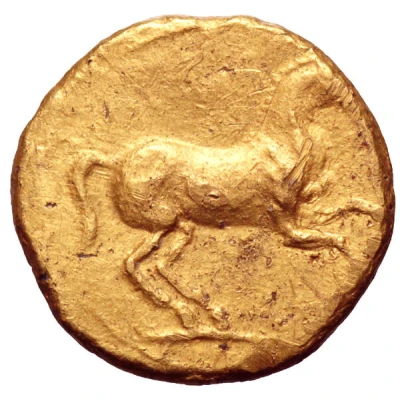


Stater 229 BC - 221 BC
| Gold | 7.53 g | 17 mm |
| Issuer | Uncertain Iberian mint (Punic Iberia) |
|---|---|
| Type | Standard circulation coin |
| Years | 229 BC - 221 BC |
| Value | 1 Stater = 12 Shekel |
| Currency | Drachm |
| Composition | Gold |
| Weight | 7.53 g |
| Diameter | 17 mm |
| Shape | Round (irregular) |
| Technique | Hammered |
| Demonetized | Yes |
| Updated | 2024-10-09 |
| Numista | N#197638 |
|---|---|
| Rarity index | 97% |
Reverse
Horse prancing to right.
Comment
Villaronga, Las monedas hispano-cartaginese, Barcelona 1973, 64; CNH 20; Hunter collection III, p. 608, 1 'Micipsa' (same dies).
In 237 BC, Hamilcar Barca, after having lost the First Punic War against Rome, but having won the Mercenary War against the Libyans, disembarked at Gadir with a Carthaginian expedition with the purpose of re-establishing Carthaginian authority in Iberia (Polybios, Histories, 2.1.6). Within 9 years, he had expanded the territory of Carthage well into the Iberian peninsula, securing control of the southern mining district of Baetica and Sierra Morena, before dying in battle in 228. Hamilcar was succeeded by his son-in-law Hasdrubal the Fair who expanded the new province by skilful diplomacy and consolidated it with the foundation of Akra Leuka (Greek: White Mountain or White Point, modern Alicante), Mahon and finally in 227, Qart Hadasht (= New Carthage = Latin: Carthago Nova, modern Cartagena), originally named Mastia, as his capital.
Interesting fact
One interesting fact about this coin is that it features a unique blend of Iberian and Punic elements, reflecting the cultural exchange and influence of the Carthaginian Empire on the Iberian Peninsula during the 3rd century BC. The coin's design includes a depiction of a warrior on horseback, which is a common motif in Iberian coinage, but it also features a Punic-style inscription and the use of the Phoenician alphabet, indicating the cultural and economic ties between the two regions. This coin is a fascinating example of the rich cultural heritage of the ancient Mediterranean world.